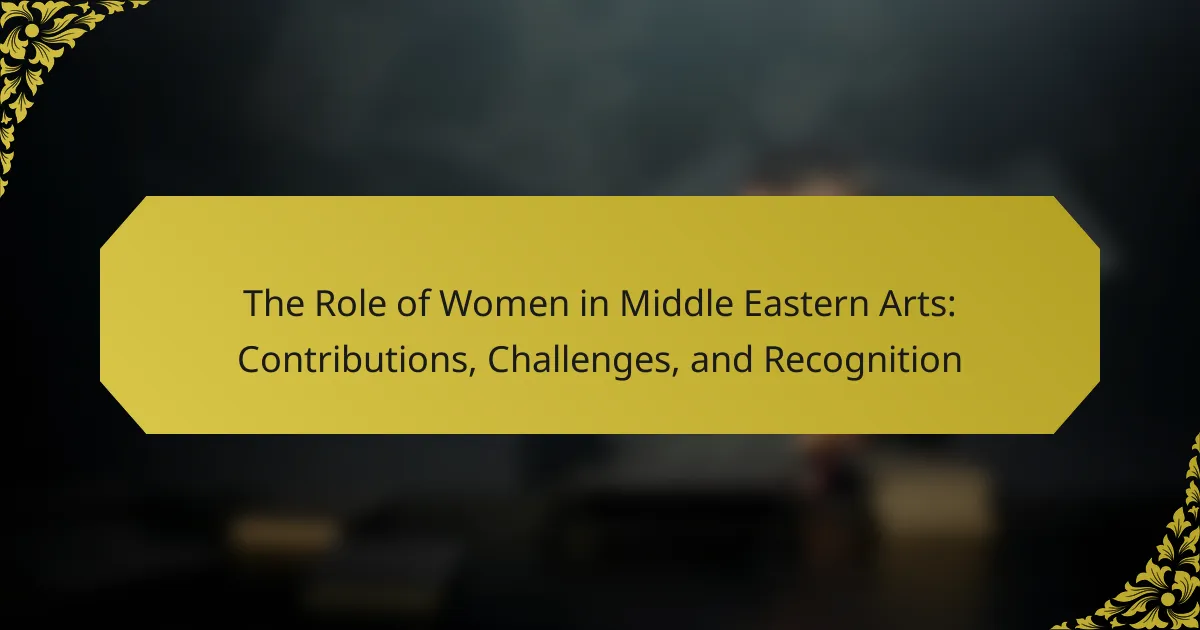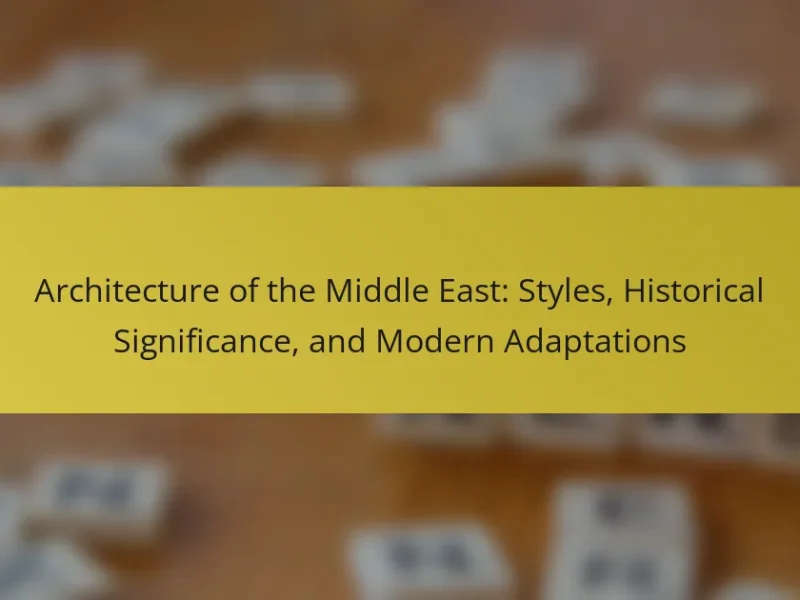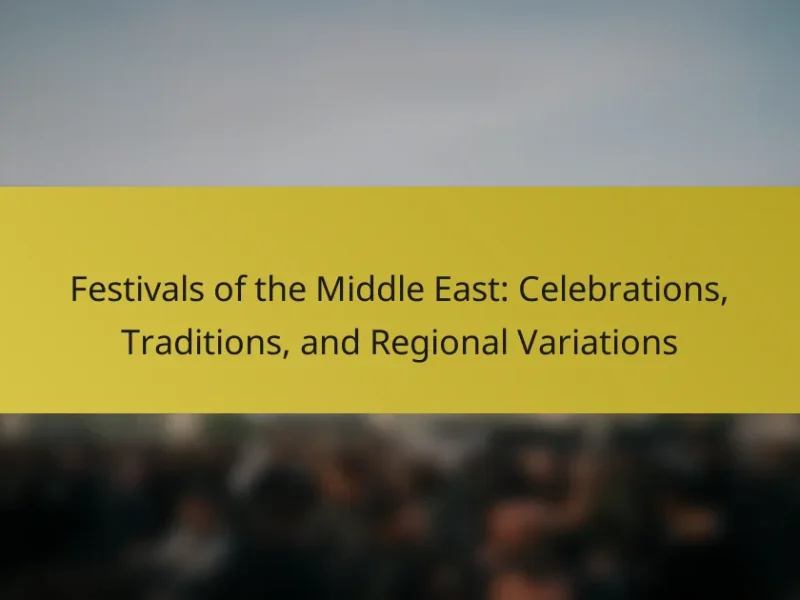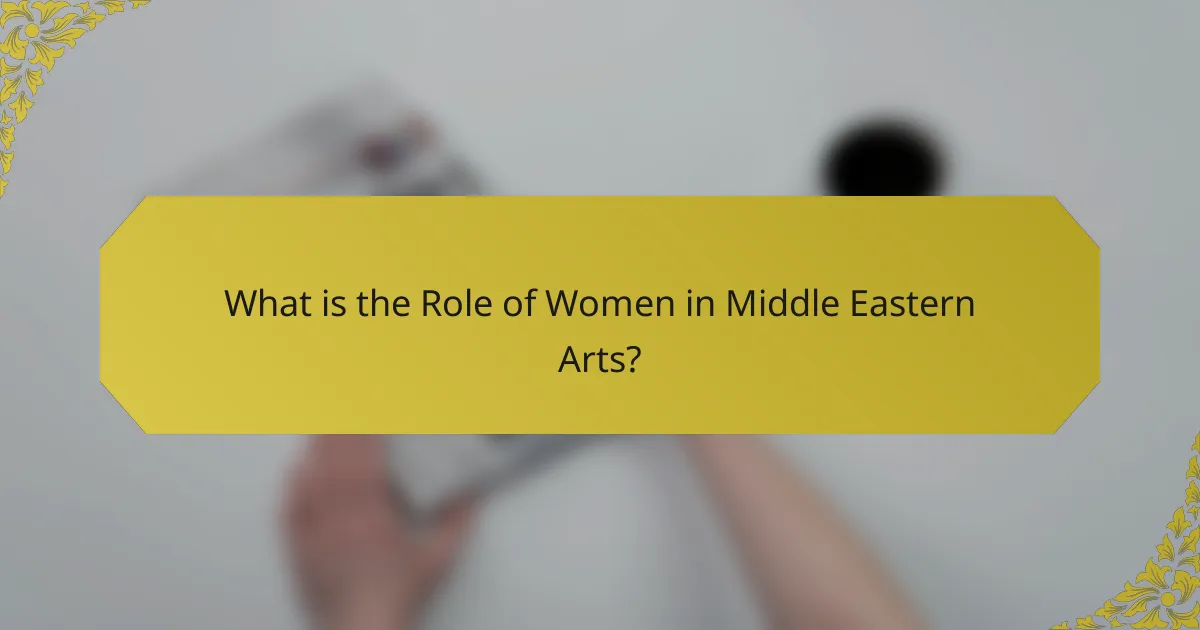
What is the Role of Women in Middle Eastern Arts?
Women play a significant role in Middle Eastern arts, contributing to various forms of expression. They engage in traditional crafts, music, dance, and visual arts. Women artists often challenge societal norms through their work. Their contributions are vital in preserving cultural heritage. Many female artists gain recognition in both local and international platforms. For instance, contemporary artists like Shirin Neshat and Zaha Hadid have received global acclaim. Despite facing challenges, such as limited access to resources, women continue to innovate. Their impact is crucial in shaping the narrative of Middle Eastern arts today.
How have women contributed to the artistic landscape in the Middle East?
Women have significantly shaped the artistic landscape in the Middle East through various forms of expression. They have excelled in visual arts, literature, music, and performing arts. Many female artists challenge societal norms and address cultural issues through their work. For instance, artists like Shirin Neshat and Zaha Hadid have gained international recognition. Neshat’s photography explores themes of gender and identity in Islamic culture. Hadid, an architect, is known for her innovative designs that push boundaries. Additionally, women writers like Hanan al-Shaykh and Elif Shafak have contributed to contemporary literature. Their narratives often reflect the complexities of women’s experiences in the region. Women in the Middle East have also organized art collectives and exhibitions, promoting female voices. This collective effort has fostered greater visibility and appreciation of women’s contributions to the arts.
What are some significant artistic movements led by women in this region?
Significant artistic movements led by women in the Middle East include the Feminist Art Movement and the Contemporary Art Movement. The Feminist Art Movement emerged in response to gender inequality in the art world. Artists such as Shirin Neshat and Mona Hatoum have played pivotal roles in this movement. They explore themes of identity, gender, and cultural representation in their works. The Contemporary Art Movement has also seen influential contributions from women. Artists like Zaha Hadid and Ghada Amer have gained international recognition. Their works challenge traditional norms and express diverse perspectives. These movements underscore the vital role of women in shaping Middle Eastern art.
How do women’s contributions differ across various art forms?
Women’s contributions differ significantly across various art forms in the Middle Eastern context. In visual arts, women often explore themes of identity and cultural heritage. They utilize traditional techniques while infusing modern perspectives. In literature, female writers challenge societal norms through storytelling. Their narratives frequently highlight women’s experiences and struggles. In music, women musicians blend traditional and contemporary styles, creating unique sounds. They often face barriers in performance opportunities but continue to gain recognition. In dance, women use movement to express cultural stories and personal emotions. Each art form showcases women’s resilience and creativity, reflecting their diverse experiences. This multifaceted involvement highlights the evolving role of women in Middle Eastern arts.
What challenges do women face in the Middle Eastern arts scene?
Women in the Middle Eastern arts scene face several significant challenges. These challenges include societal norms that limit women’s expression and participation in the arts. Cultural restrictions often dictate what is deemed acceptable for women to portray in their work. Additionally, women artists frequently encounter barriers in accessing funding and resources. Many face discrimination within the industry, hindering their career advancement. The lack of representation in galleries and exhibitions further exacerbates these issues. A study by the Arab Fund for Arts and Culture highlights that only a small percentage of women artists receive recognition in major art events. These factors collectively contribute to an environment where women’s contributions to the arts are often marginalized.
What societal and cultural barriers hinder women’s artistic expression?
Societal and cultural barriers significantly hinder women’s artistic expression. These barriers include gender stereotypes that limit women’s roles in society. Traditional views often prioritize domestic responsibilities over artistic pursuits for women. Access to education and resources for female artists is frequently restricted. Cultural norms may discourage women from publicly showcasing their work. Additionally, there is often a lack of representation in artistic institutions. Historical biases have led to underrepresentation of women’s contributions in the arts. Economic constraints further limit opportunities for women to pursue artistic careers. These factors collectively stifle women’s voices and creativity in the artistic landscape.
How do political conditions impact women’s roles in the arts?
Political conditions significantly impact women’s roles in the arts by shaping opportunities and constraints. In regions with restrictive regimes, women often face barriers to artistic expression. For example, censorship limits their ability to address social issues through their work. Conversely, in more liberal environments, women can engage more freely in artistic communities. Historical contexts, such as the Arab Spring, have shown how political upheaval can empower women artists. Women often emerge as voices for change during these transformative periods. Studies indicate that women’s participation in the arts increases in societies that promote gender equality. Thus, political conditions directly influence the visibility and recognition of women’s contributions to the arts.
What recognition do women artists receive in the Middle East?
Women artists in the Middle East receive varied recognition across different countries and artistic disciplines. In some regions, they are celebrated for their contributions to contemporary art, often gaining visibility through exhibitions and art fairs. For example, the Sharjah Biennial in the UAE has featured numerous women artists, highlighting their work on international platforms.
Additionally, awards such as the Arab Fund for Arts and Culture provide funding and support specifically for women artists. In countries like Lebanon and Egypt, women artists are increasingly represented in galleries and museums. However, challenges remain, including societal norms and limited access to resources.
Despite these hurdles, initiatives aimed at empowering women in the arts are growing. Organizations like Women in the Arts in the Middle East work to promote female artists and their work. Overall, recognition for women artists is improving, but disparities still exist based on location and cultural context.
How are women artists celebrated and acknowledged in their communities?
Women artists are celebrated and acknowledged in their communities through various platforms and initiatives. Local galleries often feature their work, providing visibility. Festivals and cultural events frequently highlight their contributions, showcasing their talent. Community organizations may host workshops led by women artists, fostering engagement and mentorship. Awards and recognition programs specifically for women artists help elevate their status. Social media plays a crucial role in amplifying their voices and work. Collaborative projects often include women artists, promoting their visibility in the art scene. Research indicates that these efforts significantly enhance community support for women in the arts. For instance, a study by the Middle East Institute highlights the increasing representation of women artists in regional exhibitions.
What platforms exist for promoting women’s art in the Middle East?
Platforms for promoting women’s art in the Middle East include online galleries, social media, and art fairs. Online galleries like Art Jameel and The Arab Digital Art are dedicated to showcasing female artists. Social media platforms such as Instagram and Facebook serve as vital tools for artists to share their work and connect with audiences. Art fairs, including the Sharjah Art Foundation and Abu Dhabi Art, often feature exhibitions focused on women artists. Additionally, initiatives like the Women’s Art Initiative in Saudi Arabia actively promote female artists through workshops and exhibitions. These platforms collectively enhance visibility and support for women’s contributions to the arts in the region.
How can the role of women in Middle Eastern arts evolve in the future?
The role of women in Middle Eastern arts can evolve through increased access to education and resources. Empowering women artists can lead to greater representation in galleries and exhibitions. Collaborative projects can foster a supportive community among female artists. Social media platforms can amplify their voices and reach wider audiences. Cultural policies that promote gender equality can create more opportunities for women. Increased funding for women-led art initiatives can enhance their visibility. Recognition of women’s contributions in historical contexts can reshape narratives. Overall, a multifaceted approach can significantly enhance women’s roles in Middle Eastern arts.
What initiatives are being taken to support women artists?
Various initiatives are being implemented to support women artists in the Middle East. Organizations are creating grants specifically for female artists. These grants help fund their projects and exhibitions. Workshops and mentorship programs are also being established to provide skill development. Collaborations between female artists and established institutions are encouraged. These partnerships aim to amplify women’s voices in the arts. Additionally, art fairs are featuring dedicated sections for women artists. This visibility helps in promoting their work to broader audiences. Research shows that such initiatives increase representation and opportunities for women in the art world.
How can increased visibility impact the recognition of women in the arts?
Increased visibility can significantly enhance the recognition of women in the arts. When women artists gain more exposure, their work reaches broader audiences. This exposure can lead to higher sales and increased opportunities for exhibitions. Research indicates that visibility correlates with recognition; for example, a study by the National Endowment for the Arts found that female artists featured in prominent galleries saw a 30% increase in public recognition. Additionally, increased visibility challenges stereotypes and biases present in the art world. It encourages institutions to showcase diverse representations of women artists. As a result, this visibility fosters a more inclusive narrative in the arts, ultimately leading to greater acknowledgment of women’s contributions.
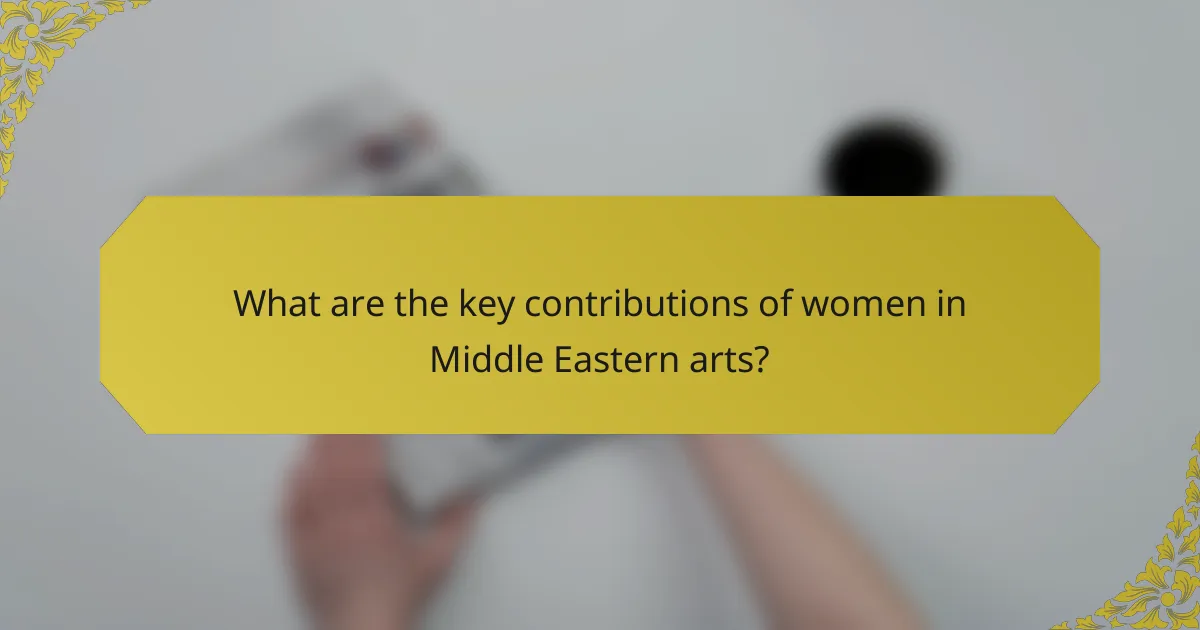
What are the key contributions of women in Middle Eastern arts?
Women have made significant contributions to Middle Eastern arts across various disciplines. They have excelled in traditional crafts, such as weaving and pottery, preserving cultural heritage. In visual arts, women artists have gained recognition for their unique perspectives and innovative techniques. Notable figures include Shirin Neshat, whose work explores identity and gender issues. Women have also been influential in music, with many composers and performers gaining acclaim. Their involvement in theater has led to the emergence of powerful narratives addressing social issues. Additionally, women have played crucial roles in literature, producing impactful poetry and prose. Their contributions have challenged societal norms and expanded the representation of women’s voices in the arts.
What forms of art are predominantly influenced by women?
Forms of art predominantly influenced by women include textiles, ceramics, and performance art. Women have historically played a significant role in textile arts, creating intricate patterns and designs. In ceramics, women often contribute unique styles that reflect cultural narratives. Performance art has also seen strong female influence, with women expressing social issues and personal stories. The contributions of women in these art forms highlight their creativity and resilience. Their work often challenges traditional norms and brings attention to gender-related themes. This influence is evident in various cultural exhibitions and festivals across the Middle East.
How does traditional art reflect women’s perspectives in the Middle East?
Traditional art in the Middle East reflects women’s perspectives through themes of identity, resilience, and cultural heritage. Women artists often depict their experiences and societal roles in their work. Traditional crafts, such as weaving and pottery, frequently incorporate motifs that symbolize women’s contributions to family and community. For instance, the use of intricate patterns can represent the complexity of women’s lives. Historical narratives in art often highlight women’s struggles and achievements. Additionally, women’s art can challenge stereotypes and promote empowerment. This representation fosters a greater understanding of women’s roles in cultural contexts. Overall, traditional art serves as a vital medium for expressing women’s voices in the region.
What contemporary art practices are shaped by women artists?
Contemporary art practices shaped by women artists include feminist art, performance art, and community-based art. Feminist art challenges traditional gender roles and explores themes of identity and representation. Performance art by women often addresses social issues and personal narratives, creating immersive experiences. Community-based art involves collaboration with local communities, emphasizing social change and cultural identity. Women artists like Shirin Neshat and Zaha Hadid exemplify these practices, using their work to address cultural and political contexts. Their contributions have significantly influenced the art world, promoting diverse perspectives and challenging the status quo.
How do women artists navigate the challenges they face?
Women artists navigate challenges through resilience, community support, and strategic networking. They often face gender bias and limited access to opportunities. Many engage in collective initiatives, forming networks to share resources. This collaboration fosters visibility and mutual support. Women artists also leverage social media to showcase their work. Online platforms provide broader reach and engagement with global audiences. Some participate in exhibitions that specifically highlight female talent. This focused attention helps to counteract mainstream biases. Additionally, women artists often address social issues in their work. This approach can resonate with audiences and create dialogue. Through these strategies, women artists continue to assert their presence in the art world.
What strategies do women employ to overcome societal barriers?
Women employ various strategies to overcome societal barriers in the Middle Eastern arts. They often utilize networking to build supportive communities. Collaborating with other artists enhances visibility and shared resources. Education plays a crucial role; women pursue formal training to gain skills and credibility. Advocacy for gender equality in the arts is another strategy; women engage in campaigns to raise awareness. Social media serves as a platform for self-promotion and showcasing their work. Participation in cultural events allows women to gain recognition and challenge stereotypes. Support from international organizations provides funding and mentorship opportunities. These strategies collectively empower women to navigate and dismantle societal barriers in the arts.
How do collaborations among women artists foster resilience?
Collaborations among women artists foster resilience by creating supportive networks. These networks provide emotional and professional support. Women artists often face unique challenges in their careers. Collaborating allows them to share resources and skills. This sharing enhances their creative output and confidence. Studies show that collaboration leads to increased innovation. For instance, joint exhibitions have been shown to attract larger audiences. This visibility can lead to greater recognition in the art community. Ultimately, these collaborations empower women artists to overcome obstacles together.
What role does education play in empowering women artists?
Education plays a crucial role in empowering women artists by providing them with the skills and knowledge necessary for artistic expression. It fosters creativity and innovation, enabling women to develop their unique voices in the art world. Access to education enhances technical abilities, which can lead to higher quality work and greater recognition.
Furthermore, education helps women artists build networks and connections within the art community. These connections can open doors to exhibitions, collaborations, and mentorship opportunities. Studies have shown that women with formal education in the arts are more likely to succeed in their careers.
For instance, a report by UNESCO highlights that educated women are more likely to participate in cultural activities and gain visibility. This visibility is essential for challenging stereotypes and expanding representation in the arts. Overall, education equips women artists with the tools to assert their presence and influence in the Middle Eastern arts landscape.
How do art institutions support female artists in the Middle East?
Art institutions in the Middle East support female artists through various initiatives. They offer grants and funding specifically for women artists. Exhibitions frequently highlight the work of female creators. Educational programs are designed to empower women in the arts. Mentorship opportunities connect emerging female artists with established professionals. Collaborative projects often involve female artists, promoting visibility. Institutions also engage in advocacy for gender equality in the art world. This support helps to challenge stereotypes and elevate women’s voices in the region’s cultural landscape.
What educational programs focus on nurturing women in the arts?
Educational programs that focus on nurturing women in the arts include initiatives such as the Women in the Arts Program. This program offers mentorship, workshops, and funding opportunities specifically for female artists. Another notable program is the Arab Women Artists Now (AWAN) initiative. AWAN supports female artists through exhibitions and networking opportunities. Additionally, the International Academy of Arts in Palestine offers courses tailored for women in various artistic disciplines. These programs aim to empower women and enhance their visibility in the arts. Studies show that such initiatives significantly increase participation rates of women in creative fields.
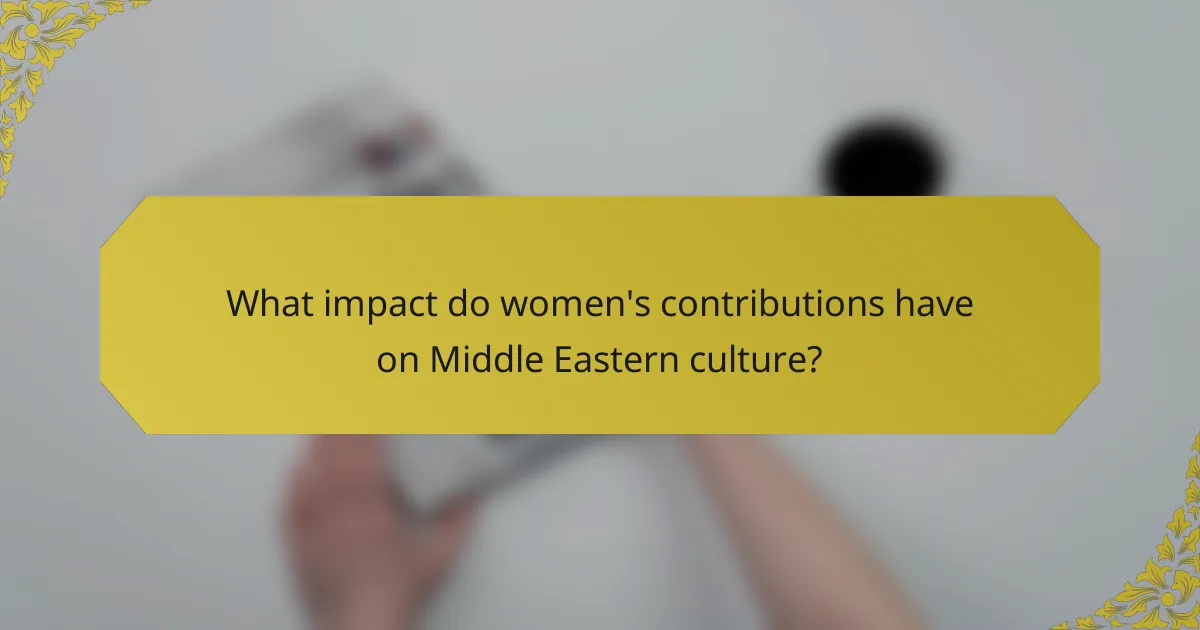
What impact do women’s contributions have on Middle Eastern culture?
Women’s contributions significantly shape Middle Eastern culture. They influence various artistic expressions, including literature, music, and visual arts. Notable female artists and writers have gained international recognition. For instance, the works of poet Nizar Qabbani highlight women’s experiences and challenges. Female musicians like Umm Kulthum have left a lasting legacy in Arabic music. Women’s participation in cultural festivals promotes diversity and inclusivity. Additionally, women play vital roles in preserving traditional crafts and storytelling. Their contributions challenge stereotypes and foster social change. Overall, women’s impact enriches the cultural landscape of the Middle East.
How do women artists influence cultural narratives in the region?
Women artists significantly influence cultural narratives in the region by challenging societal norms and expectations. They often address themes of identity, gender, and social justice through their work. This artistic expression reshapes public perceptions and encourages dialogue about women’s roles in society. For example, artists like Shirin Neshat use visual storytelling to highlight women’s experiences in Muslim cultures. Their contributions often provoke critical discussions about tradition and modernity. Furthermore, women artists frequently collaborate across disciplines, fostering community and solidarity. This collaborative spirit enhances the visibility of women’s perspectives in the cultural landscape. Overall, women artists play a crucial role in redefining cultural narratives and promoting progressive change in the region.
What themes are prevalent in the works of women artists?
Women artists often explore themes of identity, empowerment, and social justice in their works. They frequently address issues related to gender, culture, and personal experience. Many artworks reflect the struggles and resilience of women in various societies. Themes of motherhood and familial relationships are also common. Additionally, women artists often challenge traditional narratives and stereotypes. Their works may incorporate elements of feminism and intersectionality. Historical and political contexts frequently influence their artistic expressions. Overall, the themes prevalent in their works highlight the complexity of women’s experiences and perspectives.
How do these themes challenge or reinforce cultural norms?
Themes in the role of women in Middle Eastern arts challenge cultural norms by promoting gender equality and representation. Women artists often confront traditional expectations through their work. Their contributions highlight the importance of female perspectives in society. For example, female artists like Shirin Neshat use visual art to address issues of identity and oppression. This challenges the patriarchal narratives prevalent in many cultures. Conversely, these themes can also reinforce cultural norms by adhering to traditional artistic styles and subjects. Some women may choose to reflect cultural values in their work, thus maintaining societal expectations. Overall, the interplay of challenge and reinforcement is evident in the diverse expressions of women’s roles in the arts.
What are some success stories of women in Middle Eastern arts?
Women in Middle Eastern arts have achieved notable success across various disciplines. For example, Shirin Neshat, an Iranian visual artist, gained international acclaim for her photography and video installations exploring gender and identity. Her work has been exhibited in prestigious venues like the Venice Biennale.
Another success story is the Lebanese singer Fairuz, who has had a profound impact on Arabic music for decades. Her songs resonate with themes of love and nostalgia, making her an iconic figure in the region.
In literature, the Egyptian author Nawal El Saadawi is celebrated for her feminist writings. Her novels and essays challenge societal norms and advocate for women’s rights.
Additionally, the Emirati artist Muna Al Marri has made strides in contemporary art. Her installations often reflect cultural heritage and modernity, earning her recognition in art festivals worldwide.
These women exemplify the diverse contributions of female artists in the Middle East, breaking barriers and gaining recognition both locally and globally.
Who are prominent women artists making a mark today?
Prominent women artists making a mark today include Shirin Neshat, Mona Hatoum, and Zaha Hadid. Shirin Neshat is known for her powerful photography and video art that explores gender and identity in Islamic culture. Mona Hatoum’s work often addresses themes of displacement and conflict through installation art. Zaha Hadid was a groundbreaking architect recognized for her innovative and futuristic designs. Each of these artists has significantly influenced contemporary art and architecture, gaining international recognition for their contributions.
What projects highlight women’s achievements in the arts?
Projects that highlight women’s achievements in the arts include the “Women of the World” festival. This festival celebrates female artists across various disciplines. It showcases performances, exhibitions, and discussions led by women. Another notable project is the “She Inspires Me” initiative. This initiative features works by female artists from the Middle East. It aims to promote their stories and contributions. Additionally, the “Women in the Arts” program provides funding and support for female artists. These projects collectively emphasize the significant impact of women in the arts. They also raise awareness of the challenges women face in this field.
What can be done to further support women in Middle Eastern arts?
Increase funding for women-led art initiatives in the Middle East. This can help provide resources for projects and exhibitions. Establish mentorship programs connecting established artists with emerging female talents. Such programs can enhance skills and networking opportunities. Promote visibility through dedicated art fairs and exhibitions showcasing women’s work. This can raise awareness and appreciation for their contributions. Create partnerships with international art institutions to facilitate cultural exchange. This can broaden the reach of women artists beyond regional boundaries. Implement policies that encourage gender equality in art institutions. This can ensure women have equal access to opportunities and representation.
What role can audiences play in promoting women’s art?
Audiences can significantly promote women’s art by actively engaging with it. They can attend exhibitions and events showcasing female artists. This attendance increases visibility and support for women’s artistic contributions. Audiences can share their experiences on social media, amplifying the reach of women’s art. By purchasing artwork, they provide financial support to female artists. Engaging in discussions about women’s art fosters a deeper appreciation and understanding. Audiences can advocate for more representation of women in galleries and museums. Their collective voice can influence curatorial choices and funding decisions. Research shows that increased audience engagement directly correlates with greater recognition of women’s contributions in the art world.
How can policy changes improve the landscape for women artists?
Policy changes can improve the landscape for women artists by ensuring equitable access to funding and resources. Increased government support can provide grants specifically for women artists. This financial backing can help them create and showcase their work. Furthermore, policies promoting gender equality in art institutions can enhance representation. For example, implementing quotas for female artists in exhibitions can increase visibility. Additionally, education policies that support women in the arts can foster talent from an early age. Research shows that countries with supportive policies see higher participation rates among women artists. Such changes can lead to a more inclusive and diverse artistic community.
The main entity of the article is the role of women in Middle Eastern arts, highlighting their contributions, challenges, and recognition. Women significantly influence various artistic disciplines, including visual arts, literature, music, and performance, often addressing themes of identity, gender, and social justice. Despite facing societal and cultural barriers, such as limited access to resources and representation, women artists continue to innovate and gain recognition both locally and internationally. The article explores notable figures, artistic movements, and initiatives aimed at supporting female artists, while also discussing the impact of political conditions and educational opportunities on their artistic expression.
